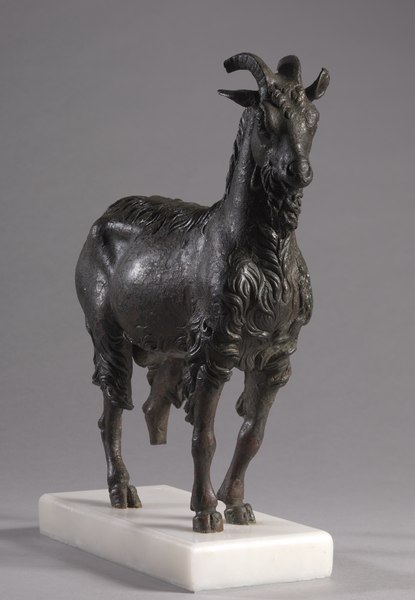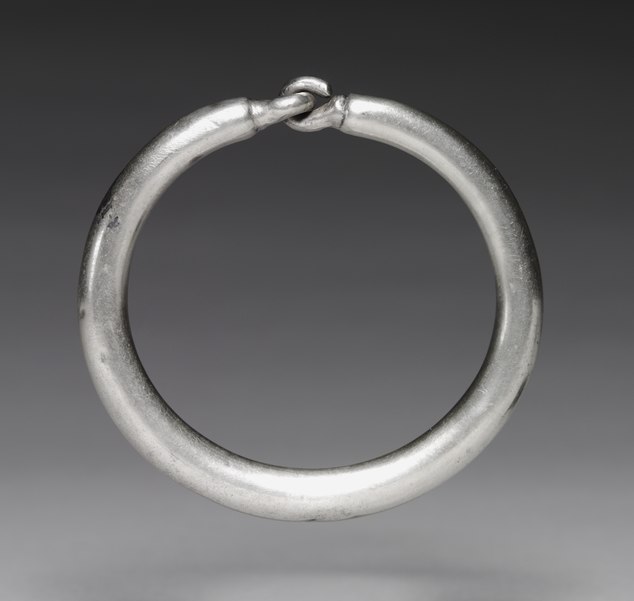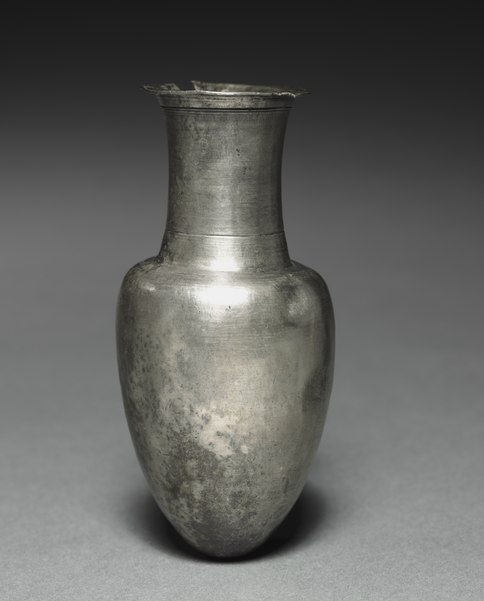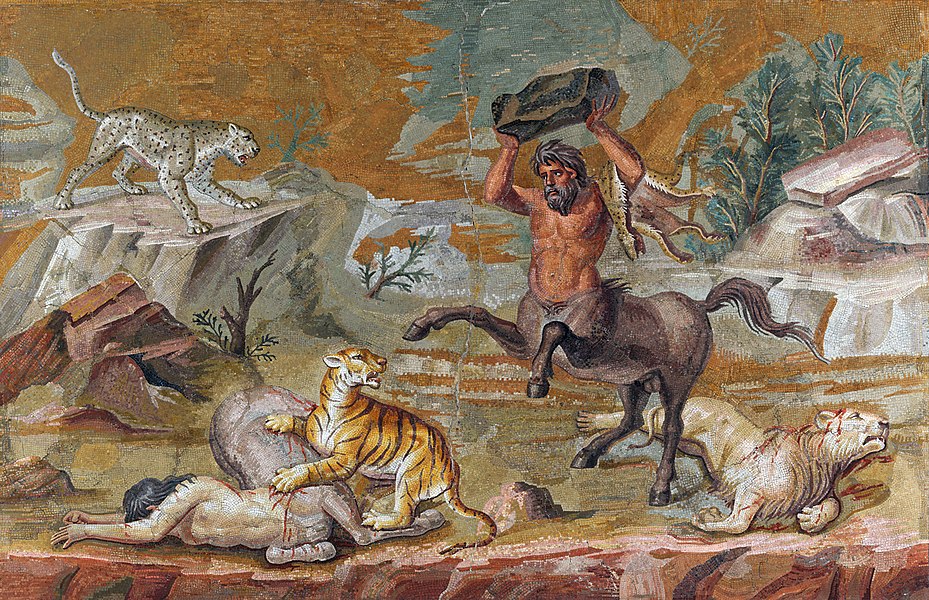 1
1title: <div class="fn"> <i>Hellenistic Ruler</i> </div>
artist: <div class="fn value"> <span lang="en">Anonymous</span> (<a href="https://en.wikipedia.org/wiki/en:Greece" class="extiw" title="w:en:Greece">Greece</a>)<span style="display:none">Unknown author</span> </div>
date: 2<sup>nd</sup> century <a href="https://en.wikipedia.org/wiki/en:Ante_Christum_Natum" class="extiw" title="w:en:Ante Christum Natum">BC</a> <div style="display: none;">date QS:P571,-150-00-00T00:00:00Z/7</div> (<a href="https://en.wikipedia.org/wiki/en:Hellenistic_period" class="extiw" title="w:en:Hellenistic period">Hellenistic period</a><div style="display: none;">era QS:P2348,Q428995</div>)
medium: solid cast bronze
dimensions: size cm height=25 width=13.7 depth=7.5
current location: Acquired by Henry Walters, 1930
credit: <a href="https://en.wikipedia.org/wiki/en:Walters_Art_Museum" class="extiw" title="w:en:Walters Art Museum">Walters Art Museum</a>: <a href="https://thewalters.org/" rel="nofollow"><img alt="Nuvola filesystems folder home.svg" src="https://upload.wikimedia.org/wikipedia/commons/thumb/8/81/Nuvola_filesystems_folder_home.svg/20px-Nuvola_filesystems_folder_home.svg.png" decoding="async" width="20" height="20" srcset="https://upload.wikimedia.org/wikipedia/commons/thumb/8/81/Nuvola_filesystems_folder_home.svg/30px-Nuvola_filesystems_folder_home.svg.png 1.5x, https://upload.wikimedia.org/wikipedia/commons/thumb/8/81/Nuvola_filesystems_folder_home.svg/40px-Nuvola_filesystems_folder_home.svg.png 2x" data-file-width="128" data-file-height="128"></a> <a rel="nofollow" class="external text" href="https://thewalters.org/">Home page</a> <a href="https://art.thewalters.org/detail/12507" rel="nofollow"><img alt="Information icon.svg" src="https://upload.wikimedia.org/wikipedia/commons/thumb/3/35/Information_icon.svg/20px-Information_icon.svg.png" decoding="async" width="20" height="20" srcset="https://upload.wikimedia.org/wikipedia/commons/thumb/3/35/Information_icon.svg/30px-Information_icon.svg.png 1.5x, https://upload.wikimedia.org/wikipedia/commons/thumb/3/35/Information_icon.svg/40px-Information_icon.svg.png 2x" data-file-width="620" data-file-height="620"></a> <a rel="nofollow" class="external text" href="https://art.thewalters.org/detail/12507">Info about artwork</a>
license:Public domain
 2
2title: <div class="fn"> <i>Hellenistic Ruler</i> </div>
artist: <div class="fn value"> <span lang="en">Anonymous</span> (<a href="https://en.wikipedia.org/wiki/en:Greece" class="extiw" title="w:en:Greece">Greece</a>)<span style="display:none">Unknown author</span> </div>
date: 2<sup>nd</sup> century <a href="https://en.wikipedia.org/wiki/en:Ante_Christum_Natum" class="extiw" title="w:en:Ante Christum Natum">BC</a> <div style="display: none;">date QS:P571,-150-00-00T00:00:00Z/7</div> (<a href="https://en.wikipedia.org/wiki/en:Hellenistic_period" class="extiw" title="w:en:Hellenistic period">Hellenistic period</a><div style="display: none;">era QS:P2348,Q428995</div>)
medium: solid cast bronze
dimensions: size cm height=25 width=13.7 depth=7.5
current location: Acquired by Henry Walters, 1930
credit: <a href="https://en.wikipedia.org/wiki/en:Walters_Art_Museum" class="extiw" title="w:en:Walters Art Museum">Walters Art Museum</a>: <a href="https://thewalters.org/" rel="nofollow"><img alt="Nuvola filesystems folder home.svg" src="https://upload.wikimedia.org/wikipedia/commons/thumb/8/81/Nuvola_filesystems_folder_home.svg/20px-Nuvola_filesystems_folder_home.svg.png" decoding="async" width="20" height="20" srcset="https://upload.wikimedia.org/wikipedia/commons/thumb/8/81/Nuvola_filesystems_folder_home.svg/30px-Nuvola_filesystems_folder_home.svg.png 1.5x, https://upload.wikimedia.org/wikipedia/commons/thumb/8/81/Nuvola_filesystems_folder_home.svg/40px-Nuvola_filesystems_folder_home.svg.png 2x" data-file-width="128" data-file-height="128"></a> <a rel="nofollow" class="external text" href="https://thewalters.org/">Home page</a> <a href="https://art.thewalters.org/detail/12507" rel="nofollow"><img alt="Information icon.svg" src="https://upload.wikimedia.org/wikipedia/commons/thumb/3/35/Information_icon.svg/20px-Information_icon.svg.png" decoding="async" width="20" height="20" srcset="https://upload.wikimedia.org/wikipedia/commons/thumb/3/35/Information_icon.svg/30px-Information_icon.svg.png 1.5x, https://upload.wikimedia.org/wikipedia/commons/thumb/3/35/Information_icon.svg/40px-Information_icon.svg.png 2x" data-file-width="620" data-file-height="620"></a> <a rel="nofollow" class="external text" href="https://art.thewalters.org/detail/12507">Info about artwork</a>
license:Public domain
 3
3title: <div class="fn"> <i>Hellenistic Ruler</i> </div>
artist: <div class="fn value"> <span lang="en">Anonymous</span> (<a href="https://en.wikipedia.org/wiki/en:Greece" class="extiw" title="w:en:Greece">Greece</a>)<span style="display:none">Unknown author</span> </div>
date: 2<sup>nd</sup> century <a href="https://en.wikipedia.org/wiki/en:Ante_Christum_Natum" class="extiw" title="w:en:Ante Christum Natum">BC</a> <div style="display: none;">date QS:P571,-150-00-00T00:00:00Z/7</div> (<a href="https://en.wikipedia.org/wiki/en:Hellenistic_period" class="extiw" title="w:en:Hellenistic period">Hellenistic period</a><div style="display: none;">era QS:P2348,Q428995</div>)
medium: solid cast bronze
dimensions: size cm height=25 width=13.7 depth=7.5
current location: Acquired by Henry Walters, 1930
credit: <a href="https://en.wikipedia.org/wiki/en:Walters_Art_Museum" class="extiw" title="w:en:Walters Art Museum">Walters Art Museum</a>: <a href="https://thewalters.org/" rel="nofollow"><img alt="Nuvola filesystems folder home.svg" src="https://upload.wikimedia.org/wikipedia/commons/thumb/8/81/Nuvola_filesystems_folder_home.svg/20px-Nuvola_filesystems_folder_home.svg.png" decoding="async" width="20" height="20" srcset="https://upload.wikimedia.org/wikipedia/commons/thumb/8/81/Nuvola_filesystems_folder_home.svg/30px-Nuvola_filesystems_folder_home.svg.png 1.5x, https://upload.wikimedia.org/wikipedia/commons/thumb/8/81/Nuvola_filesystems_folder_home.svg/40px-Nuvola_filesystems_folder_home.svg.png 2x" data-file-width="128" data-file-height="128"></a> <a rel="nofollow" class="external text" href="https://thewalters.org/">Home page</a> <a href="https://art.thewalters.org/detail/12507" rel="nofollow"><img alt="Information icon.svg" src="https://upload.wikimedia.org/wikipedia/commons/thumb/3/35/Information_icon.svg/20px-Information_icon.svg.png" decoding="async" width="20" height="20" srcset="https://upload.wikimedia.org/wikipedia/commons/thumb/3/35/Information_icon.svg/30px-Information_icon.svg.png 1.5x, https://upload.wikimedia.org/wikipedia/commons/thumb/3/35/Information_icon.svg/40px-Information_icon.svg.png 2x" data-file-width="620" data-file-height="620"></a> <a rel="nofollow" class="external text" href="https://art.thewalters.org/detail/12507">Info about artwork</a>
license:Public domain
 4
4title: <div class="fn"> Hellenistic Lagynos</div>
artist: unknown
date: 325 B.C.
dimensions: Height- 12 in. (30.48 cm)
current location: Institution:Los Angeles County Museum of Art
source: *Image: http://collections.lacma.org/sites/default/files/remote_images/piction/ma-31940738-O3.jpg *Gallery: http://collections.lacma.org/node/229803 Wayback|url=https%3A//collections.lacma.org/node/229803|date=20180204124203
credit: <ul> <li>Image: <a rel="nofollow" class="external free" href="http://collections.lacma.org/sites/default/files/remote_images/piction/ma-31940738-O3.jpg">http://collections.lacma.org/sites/default/files/remote_images/piction/ma-31940738-O3.jpg</a> </li> <li>Gallery: <a rel="nofollow" class="external free" href="http://collections.lacma.org/node/229803">http://collections.lacma.org/node/229803</a> <bdo lang="en" dir="ltr" title="archived on 4 February 2018 at the Wayback Machine"><a rel="nofollow" class="external text" href="https://web.archive.org/web/20180204124203/https%3A//collections.lacma.org/node/229803">archive copy</a></bdo> </li> </ul>
description: <br><dl> <dd>Eastern Mediterranean, Cyprus, 325-50 B.C.</dd> <dd>Furnishings; Serviceware</dd> <dd>Ceramic</dd> <dd>Gift of Harvey Mudd (M.49.14.32)</dd> <dd><a rel="nofollow" class="external text" href="http://www.lacma.org/art/collection/<u style="background-color:yellow;" class="">greek</u>-roman-<u style="background-color:yellow;" class="">and</u>-etruscan-art"><u style="background-color:yellow;" class="">greek</u>, Roman <u style="background-color:yellow;" class="">and</u> Etruscan Art</a></dd> </dl>
license:Public domain
 5
5title: <div class="fn"> Nanny Goat</div>
artist: unknown
date: late 2nd Century BC
medium: Bronze
dimensions: Overall: 30.5 x 31.1 cm (12 x 12 1/4 in.)
current location: institution:Cleveland Museum of Art
source: https://clevelandart.org/art/1990.32
credit: <a rel="nofollow" class="external free" href="https://clevelandart.org/art/1990.32">https://clevelandart.org/art/1990.32</a>
description: <div class="description"> Goats were among the earliest domesticated animals <u style="background-color:yellow;" class="">and</u> figured prominently in <u style="background-color:yellow;" class="">greek</u> art <u style="background-color:yellow;" class="">and</u> mythology since at least the 8th century BC. This example with its powerful stance, curly beard, <u style="background-color:yellow;" class="">and</u> horns is not a ram but an expecting doe with swollen flanks. The subject is rare <u style="background-color:yellow;" class="">and</u> its meaning unclear. Possibly she was part of a group dedication to a goddess. The sunken areas at the tail <u style="background-color:yellow;" class="">and</u> hips <u style="background-color:yellow;" class="">and</u> her open mouth, indicating heavy breathing, are signs that she is ready to give birth.</div>
license:CC0
 6
6title: <div class="fn"> Bracelet</div>
artist: unknown
date: 2nd-1st Century BC
medium: Silver
dimensions: Diameter: 8.3 cm (3 1/4 in.)
current location: institution:Cleveland Museum of Art
source: https://clevelandart.org/art/1986.182
credit: <a rel="nofollow" class="external free" href="https://clevelandart.org/art/1986.182">https://clevelandart.org/art/1986.182</a>
license:CC0
 7
7title: <div class="fn"> Amphoriskos</div>
artist: unknown
date: 2nd-1st Century BC
medium: Silver
dimensions: Overall: 11.7 cm (4 5/8 in.)
current location: institution:Cleveland Museum of Art
source: https://clevelandart.org/art/1986.183
credit: <a rel="nofollow" class="external free" href="https://clevelandart.org/art/1986.183">https://clevelandart.org/art/1986.183</a>
license:CC0
 8
8title: <div class="fn"> Grave Stele (Relief)</div>
artist: unknown
date: c. 50 BC
medium: Marble
dimensions: Overall: 73.6 x 42.5 cm (29 x 16 3/4 in.)
current location: institution:Cleveland Museum of Art
source: https://clevelandart.org/art/2005.52
credit: <a rel="nofollow" class="external free" href="https://clevelandart.org/art/2005.52">https://clevelandart.org/art/2005.52</a>
description: <div class="description"> The multiple figures, inscription, use of perspective, <u style="background-color:yellow;" class="">and</u> architectural frame distinguish this ambitious relief as one of the most important of its type. The <u style="background-color:yellow;" class="">greek</u> inscription on the base reads, “To Sbardia, also named Tate, Eumelos, son of Aphrodisios, her father, [set this up].” The deceased is shown seated on an elaborate chair. A servant girl holding a fan suggests Sbardia's high social standing. At the bottom right corner, a hen perches on an upturned basket, a symbol of “the good life.” The stele incorporates a “springing” gable supported by engaged half columns with simplified Corinthian capitals. Other features relate to beliefs about mortality <u style="background-color:yellow;" class="">and</u> the afterlife. Above <u style="background-color:yellow;" class="">and</u> to the left of her chair is her winged psyche (soul) shown leaving her body. Figures of the three fates are shown in the pediment above, reminding us that human life is finite.</div>
license:CC0
 9
9title: <div class="fn"> <span ><span dir="ltr" lang="en"><i>Centaur mosaic</i></span></span><div style="display: none;">title QS:P1476,en:"Centaur mosaic"</div> <div style="display: none;">label QS:Len,"Centaur mosaic"</div> </div>
artist: <div class="fn value"> Unknown<br><a rel="nofollow" class="external text" href="http://www.googleartproject.com/artist/unknown/4128544/">Details of artist on Google Art Project</a> </div>
date: (120 - 130)
dimensions: w915 x h585 cm
current location: Altes Museum, Staatliche Museen zu Berlin
credit: <p><a rel="nofollow" class="external text" href="//www.google.com/culturalinstitute/asset-viewer/SwHAQhNGz6l7_Q">SwHAQhNGz6l7_Q at Google Cultural Institute</a> zoom level scaled </p> down from maximum resolution
description: The centaur mosaic was found in the 18th century on the site of the sprawling, luxurious villa complex near Tivoli that once belonged to the Roman emperor Hadrian. The mosaic was found in situ along with other smaller ones that bore depictions of landscapes, animals <u style="background-color:yellow;" class="">and</u> masks. The relatively small central panel (emblema) formed part of the floor decoration for the dining room (triclinium) in the main palace. The various individual scenes of these mosaic pictures bear depictions of wild, inhospitable landscapes that deliberately contrast with idyllic ones featuring animals living in harmony with each other. The dangers of the wild are portrayed in this mosaic in the dramatic struggle between great cats <u style="background-color:yellow;" class="">and</u> a pair of centaurs, mythological creatures with the head, arms, <u style="background-color:yellow;" class="">and</u> torso of a man <u style="background-color:yellow;" class="">and</u> the body <u style="background-color:yellow;" class="">and</u> legs of a horse. On a rocky outcrop that hangs over a terrific chasm that runs parallel to the bottom of the picture, a pair of centaurs have been pounced on by great cats. While the male centaur has been able to defend itself successfully from the lion, the tiger has managed to bring the female centaur to the ground <u style="background-color:yellow;" class="">and</u> is clawing her side. The male centaur rushes to his companion’s side, rearing his legs in the air while holding a rock aloft above his head. Undaunted, the tiger seems intent on not surrendering its prey. Even though one lion already lies fatally wounded, bleeding <u style="background-color:yellow;" class="">and</u> with its claws retracted, the outcome of the struggle is anything but clear because in the background (whose spatial depth is achieved through the staggered arrangement of rock forms <u style="background-color:yellow;" class="">and</u> impressive gradations of colour) we see yet another foe for the centaur: a leopard ready to pounce. While depictions in older <u style="background-color:yellow;" class="">greek</u> art tended to emphasise the bestial side of centaurs, later depictions increasingly focussed on their human qualities. Lucian, a writer from the 2nd century, records that the <u style="background-color:yellow;" class="">greek</u> painter Zeuxis (active around 400 BCE) became famous for his painting of a family of centaurs, including the young, set in a rural idyll. Similarly, Ovid, who lived around the turn of the millennium, wrote in moving verse of the death of a centaur couple. The extensive restoration work that was undertaken in the 18th <u style="background-color:yellow;" class="">and</u> 19th century makes it difficult to date the mosaic with certainty. As a result, its dating ranges from <u style="background-color:yellow;" class="">hellenistic</u> to Hadrianic. There is broad agreement among scholars that the mosaic amounts to one of most virtuoso works of Roman mosaic art, which was inspired by a <u style="background-color:yellow;" class="">greek</u> work of art (either a panel painting or mosaic) from the <u style="background-color:yellow;" class="">hellenistic</u> period.
license:Public domain
 10
10title: <div class="fn"> <span ><span dir="ltr" lang="en"><i>Centaur mosaic</i></span></span><div style="display: none;">title QS:P1476,en:"Centaur mosaic"</div> <div style="display: none;">label QS:Len,"Centaur mosaic"</div> </div>
artist: <div class="fn value"> Unknown<br><a rel="nofollow" class="external text" href="http://www.googleartproject.com/artist/unknown/4128544/">Details of artist on Google Art Project</a> </div>
date: (120 - 130)
dimensions: w915 x h585 cm
current location: Altes Museum, Staatliche Museen zu Berlin
credit: <a rel="nofollow" class="external text" href="//www.google.com/culturalinstitute/asset-viewer/SwHAQhNGz6l7_Q">SwHAQhNGz6l7_Q at Google Cultural Institute</a> maximum zoom level
description: The centaur mosaic was found in the 18th century on the site of the sprawling, luxurious villa complex near Tivoli that once belonged to the Roman emperor Hadrian. The mosaic was found in situ along with other smaller ones that bore depictions of landscapes, animals <u style="background-color:yellow;" class="">and</u> masks. The relatively small central panel (emblema) formed part of the floor decoration for the dining room (triclinium) in the main palace. The various individual scenes of these mosaic pictures bear depictions of wild, inhospitable landscapes that deliberately contrast with idyllic ones featuring animals living in harmony with each other. The dangers of the wild are portrayed in this mosaic in the dramatic struggle between great cats <u style="background-color:yellow;" class="">and</u> a pair of centaurs, mythological creatures with the head, arms, <u style="background-color:yellow;" class="">and</u> torso of a man <u style="background-color:yellow;" class="">and</u> the body <u style="background-color:yellow;" class="">and</u> legs of a horse. On a rocky outcrop that hangs over a terrific chasm that runs parallel to the bottom of the picture, a pair of centaurs have been pounced on by great cats. While the male centaur has been able to defend itself successfully from the lion, the tiger has managed to bring the female centaur to the ground <u style="background-color:yellow;" class="">and</u> is clawing her side. The male centaur rushes to his companion’s side, rearing his legs in the air while holding a rock aloft above his head. Undaunted, the tiger seems intent on not surrendering its prey. Even though one lion already lies fatally wounded, bleeding <u style="background-color:yellow;" class="">and</u> with its claws retracted, the outcome of the struggle is anything but clear because in the background (whose spatial depth is achieved through the staggered arrangement of rock forms <u style="background-color:yellow;" class="">and</u> impressive gradations of colour) we see yet another foe for the centaur: a leopard ready to pounce. While depictions in older <u style="background-color:yellow;" class="">greek</u> art tended to emphasise the bestial side of centaurs, later depictions increasingly focussed on their human qualities. Lucian, a writer from the 2nd century, records that the <u style="background-color:yellow;" class="">greek</u> painter Zeuxis (active around 400 BCE) became famous for his painting of a family of centaurs, including the young, set in a rural idyll. Similarly, Ovid, who lived around the turn of the millennium, wrote in moving verse of the death of a centaur couple. The extensive restoration work that was undertaken in the 18th <u style="background-color:yellow;" class="">and</u> 19th century makes it difficult to date the mosaic with certainty. As a result, its dating ranges from <u style="background-color:yellow;" class="">hellenistic</u> to Hadrianic. There is broad agreement among scholars that the mosaic amounts to one of most virtuoso works of Roman mosaic art, which was inspired by a <u style="background-color:yellow;" class="">greek</u> work of art (either a panel painting or mosaic) from the <u style="background-color:yellow;" class="">hellenistic</u> period.
license:Public domain





